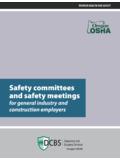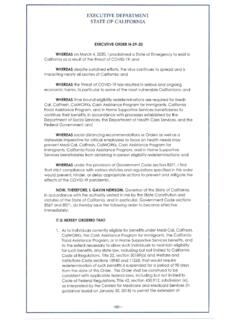Transcription of SAFETY ORIENTATION GUIDE FOR NEW EMPLOYEES
1 Published by CIRSA3665 Cherry Creek North Drive Denver, Colorado FAX CIRSA 2014 SAFETY ORIENTATION GUIDEFOR NEW EMPLOYEES1 SAFETY ORIENTATION GUIDE for New EMPLOYEES Introduction: The purpose of this GUIDE is to provide a framework for conducting SAFETY orientations for new EMPLOYEES . Accident statistics show that new EMPLOYEES are much more likely to sustain on-the-job injuries that more experienced workers. Therefore, it is essential that new EMPLOYEES receive a detailed SAFETY ORIENTATION in order to provide them with the knowledge and skills needed to perform their jobs safely and prevent accidents. SAFETY should be a priority for new EMPLOYEES from the first day of employment. They should be told of your entity s commitment to SAFETY and the expectation that all EMPLOYEES will perform their jobs safely and avoid accidents. Whether the ORIENTATION is conducted by a supervisor, risk manager, personnel representative or other official, certain SAFETY -related information should be reviewed.
2 Module 1 of this GUIDE is designed to cover much of the general SAFETY information that virtually all new EMPLOYEES need to hear. Other safe job procedures should be reviewed with EMPLOYEES prior to their assignment to a task that exposes them to specific hazards. Module 2 is designed to prompt the review of hazards and SAFETY procedures associated with certain hazardous tasks. While we have attempted to design the ORIENTATION GUIDE in a comprehensive manner, it is not possible to cover every conceivable SAFETY hazard, policy or procedure that EMPLOYEES need to know about. Henceforth, municipal officials responsible for conducting SAFETY orientations should modify this document as appropriate to ensure that everything that should be reviewed with new EMPLOYEES is adequately covered. Planning the SAFETY ORIENTATION : The SAFETY ORIENTATION should be coordinated with other departments (such as personnel, risk management, etc.)
3 As appropriate. The person(s) responsible for conducting the ORIENTATION should be notified far enough in advance so they can plan their workday. Most employers have a formal sign-in procedure where employee payroll, benefits, and other personnel-related policies are reviewed. After this process is completed, the SAFETY ORIENTATION should be conducted. For more than one employee, a classroom set-up is usually best. Arrangements can be made to have a TV/DVD player, LCD Projector and/or flip charts, white boards or smart boards. Adequate copies should be made of pertinent policies and procedures, and samples of personal protective equipment and other visual materials assembled prior to the ORIENTATION . The meeting room should be well lit and away from noisy areas and other distractions. An adequate amount of time should be planned so you don t have to rush through important information. Conducting the SAFETY ORIENTATION : The first day on the job typically involves many new faces and information that EMPLOYEES try 2 their best to absorb.
4 In reality, the amount of information that they will be able to retain is limited. With this is mind, the initial segment of the SAFETY ORIENTATION should cover general information that is not critical to their survival, unless of course they are required to perform a hazardous activity on the first day. Information given to new EMPLOYEES on the first day should include a discussion of the entity s commitment to SAFETY and other basic SAFETY information. Module 1 provides a checklist of key topics that should be covered on day one. The left side of the checklist includes boxes where the instructor can check yes if the topic has been reviewed, no if it hasn t, and n/a if the item is not applicable to the particular employee(s) involved. Under each topic are notes to the instructor, key points, and resources. The notes to instructor prompt the person conducting the ORIENTATION to gather and review various policies and procedures, coordinate additional training, etc.
5 A resource section is also included under each topic. This section lists the written documents and videos that CIRSA has already provided to help you conduct the ORIENTATION . Appendix A lists additional resources you can use to conduct the ORIENTATION . Module 2 contains checklists that are specific to certain job activities. While these items may be covered the first day, it is probably best to wait to review them later so EMPLOYEES aren t too overloaded with information. The checklists in Module 2 do not cover everything there is to know about the subject. More in-depth training will be necessary so EMPLOYEES are fully aware of potential hazards and safe job procedures. Documentation: It is important that you document the SAFETY ORIENTATION as well as any other SAFETY training. A sample roster sheet can be found in Appendix B after the checklists of topics. Follow-up: As mentioned earlier, EMPLOYEES will not retain all the information that you review with them during the SAFETY ORIENTATION .
6 Therefore, follow-up training may be necessary to review key SAFETY policies, procedures and hazards. Additional training classes may be needed to teach specific job skills in order to prevent accidents and injuries. CIRSA s SAFETY Training Curriculum GUIDE lists specific SAFETY training requirements by municipal department. Also, retraining may be needed if an accident occurs or an employee is performed performing a job or task unsafely. This training could take the form of informal coaching. Be sure to document any follow-up training. Disclaimer: This publication is provided for informational purposes only. As with all CIRSA loss control activities, this GUIDE is intended only to assist CIRSA members in their own loss control activities. It is not intended to replace those programs or activities, or to provide specific legal, technical, or other advice. Members should seek professional advice on specific concerns from their own legal, technical other advisors.
7 3 SAFETY ORIENTATION Module No. 1 Date:_____ Employee: _____ Instructor: _____ SAFETY Policy and Responsibilities Reviewed Yes No N/A SAFETY Policy Notes to Instructor: 1. Review the entity's SAFETY policy with the employee. 2. Present a copy of the SAFETY policy and have EMPLOYEES acknowledge receipt by signing they have read and understood the policy. Yes No N/A SAFETY Responsibilities Notes to Instructor: 1. Review EMPLOYEES ' responsibilities for SAFETY . 2. Review role of SAFETY coordinator and/or SAFETY committees. The SAFETY coordinator is _____. 3. Review any standards for SAFETY in the performance evaluation system. 4. Review with the employee how a violation of SAFETY rules can affect result in disciplinary action or other consequences. Key Points: 1. The entity's evaluation contains criteria to gauge your conformance on SAFETY issues, and to impose discipline for violations.
8 Resources: CIRSA Loss Control Manual - Section I Accident Reporting Yes No N/A Reporting Accidents and Near Misses Notes to Instructor: 1. Review the entity's accident reporting procedures. Key Points: 1. Report on-the-job accidents to your immediate supervisor as soon as possible; but no later than 24 hours after the accident. 4 2. An accident investigation will be conducted to see how the accident could have been prevented. 3. If you observe any unsafe conditions or actions, contact your supervisor. These situations will be reviewed to see if changes in the operation or equipment may be appropriate. 4. If a near miss accident occurred that could have caused injury or property damage, notify your supervisor to determine ways to prevent a future occurrence. Resources: CIRSA Loss Control Manual; Section II-4 (Supervisor's Investigation Report) CIRSA video and handbook Don t Play the Blame Game CIRSA SAFETY Stops p.
9 60 Yes No N/A First Aid Notes to Instructor: 1. Point out the locations of first aid kits, AED s, and emergency eyewash/shower stations during a tour of the facility. Key Points 1. If an injury does not require medical attention, administer the appropriate first aid using supplies from a nearby first aid kit. 2. Know the locations of the nearest first aid kits and AED s in your work area. 3. If first aid supplies are low, insufficient, or outdated, contact your supervisor. 4. Know the locations of any eyewashes or emergency showers in your work area. 5. Let your supervisor know of the incident and determine whether it could have been prevented. 6. Keep in mind that an injury may be worse than first indicated and later merit medical attention. It is best to report in the event of later infection. Yes No N/A Workers' Compensation Claims Notes to Instructor: 1.
10 Point out the Federal and State posters related to injury reporting and treatment and your rights under Federal and State laws. Key Points: 1. All work related injuries must be reported to your supervisor. 2. You must complete an "Employee's Written notice of Injury to Employer" form within four working days of the injury. 3. _____ is responsible for filing workers' compensation claims. If you have any questions regarding a claim, contact him/her. 5 4. Workers' compensation applies to medical expenses that are incurred for approved treatments and also covers a portion of your lost time under specified circumstances. 5. If you need medical assistance, you must see the designated medical provider first. 6. Our designated providers are _____. 7. If you go to another medical provider, you may not be eligible for workers' compensation benefits.




